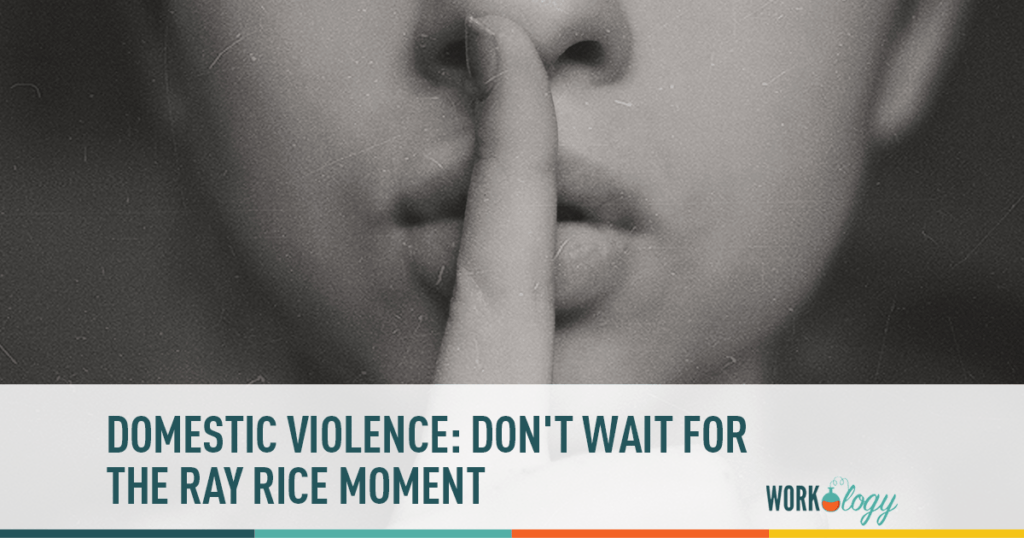On September 8, 2014, many of us watched a video clip showing NFL player Ray Rice punching his wife unconscious in a casino elevator. The video sparked wide-ranging and heated discussions about whether and how the NFL should address domestic and sexual violence. The outcry was appropriate, but unfortunately, this is not a new issue. And this is not just a “sports problem.”
How Domestic Violence Impacts Employers & How They Can Help
Employers in all industries play an important role in connecting victims with assistance, holding perpetrator-employees accountable, providing leave for victims of violence, and addressing the productivity and safety impacts of violence on the workplace. Human Resources (HR) personnel are often among the first to hear about an incident or issue with an employee, and therefore are in a position to be “first responders” when it comes to addressing the workplace impacts of domestic and sexual violence. HR can spearhead a proactive, comprehensive workplace program to prevent and address violence.
A recent study by the Centers for Disease Control indicates that sexual violence, stalking, and domestic violence are widespread in the United States among both women and men. More than 1 in 3 women and more than 1 in 4 men in the United States have experienced rape, physical violence, and/or stalking by an intimate partner in their lifetime. Given the prevalence, it’s likely your employees, coworkers, customers, or clients will be affected—either as victims or perpetrators.
Addressing the workplace impacts of such violence is not just the right thing to do for your employees; it makes economic sense as well. The annual cost of lost productivity due to domestic violence is more than $700 million. Improvements in employee performance, productivity, trust, and retention are all positive outcomes for employers that take steps to prevent domestic and sexual violence. The costs of preventative measures are far outweighed by the significant human and economic costs to employees, business, and reputation after a violent incident.
Here are six ways to ensure your workplace—large or small—has a comprehensive, proactive program to help prevent and address domestic and sexual violence.
1. Build a Multidisciplinary Response Team
The workplace impacts of domestic and sexual violence are complex, and require the expertise and action of different people within the organization. In addition to HR, the team should include people from the Employee Assistance Program (EAP), legal, security, and the union, for example.
2. Raise Awareness
A few simple steps will let people in the workplace – employees, customers and clients – know that your company is committed to supporting victims and holding perpetrators accountable. Put up a poster, or place our safety cards in bathrooms or break rooms to indicate that there is help for victims, and list the contact information for national and local resources.
3. Conduct a Workplace Risk/Threat Assessment
Workplaces are often the scenes for domestic and sexual violence because they may serve as the only place where a perpetrator can readily locate or access an intended victim, in person or electronically. Not surprisingly, stalking is the most prevalent form of abuse at work. Workplaces should undertake a general security assessment for all business locations, including the following questions:
- Can non-employees physically enter the workplace without presenting identification or interacting with security?
- Are employee work schedules, home and work phone numbers and addresses easily accessible?
- Does the parking lot, and/or the path to the nearest public transportation, have adequate lighting?
- Are there areas of the workplace where employees are isolated or alone for long periods of time?
4. Develop and Implement Workplace Policies/Protocols
A policy addressing domestic and sexual violence and stalking is critical to prevention, education and response efforts, as well as avoiding liability. However, a 2013 survey conducted by Futures Without Violence and the Society for Human Resource Management (SHRM) found that while over one-half (54%) of organizations had a policy addressing sexual violence, only one-third had a policy addressing domestic violence (35%) and stalking (31%). Our policy design tool and our interactive training exercises can help you think through some of the issues to be addressed in a policy, and provide model language.
5. Educate and Train Company Leaders and Employees
A policy is just a piece of paper if no one knows it exists or how to use it. In the same Futures Without Violence-SHRM survey, only one-third of organizations offered formal training to employees addressing sexual violence, and one in five offered training on domestic violence and stalking. Ensure that your employees know what is expected of them and where to go if they need assistance. Our short training video can help.
6. Build Relationships with Domestic and Sexual Violence Service Providers and Law Enforcement in your Community
While it’s important for you and your employees to understand how to recognize and respond to issues related to domestic and sexual violence, it’s not your job to “solve” the victim or perpetrator’s problems or advise them on how to do so. You don’t have to be an expert in this area; you just need to know who the experts are and how to contact them. Make sure that your HR team and EAP providers have a list of organizations and contact information at the national, state, and local levels that can provide specialized services to victims of domestic or sexual violence, including shelters, counselors, criminal justice, etc.
For more information on designing a comprehensive workplace violence program, see the Workplaces Respond website.
Photo courtesy of Jordan Sanchez.









